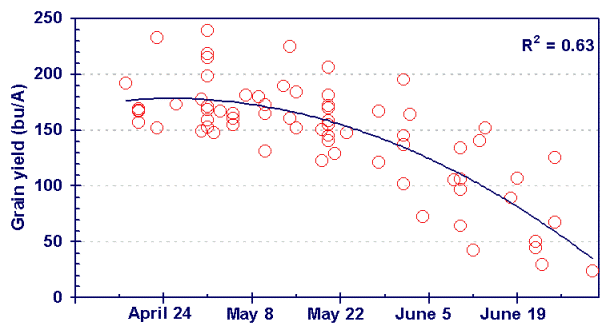Earlier Planting Dates for Corn:
Real Progress or an Effect of Global Warming?
June 7, 2001 8(12):83-85
Joe Lauer, Corn Agronomist
Weather this past growing season has delayed corn planting in many areas of Wisconsin.
It is a reminder though of the importance of planting date in grain production management.
Over the years planting date practices have changed where farmers plant corn earlier
today than a generation ago. One factor could be that weather is changing allowing
for more milder growing conditions during the planting season. Also, new technologies
and products have appeared recently that improve a corn plant's ability to withstand
early season stress. These technologies include:
- breeding hybrids for early season vigor and tolerance to more difficult seedling
growing conditions like stress from wet cool soils,
- improved seed treatments that protect the seedling from early season diseases and
insects, and
- equipment modifications that improve seed placement and the ability of the planter
to function under sometimes difficult conditions.
Is weather really changing or have new technologies allowed earlier planting today
versus a generation ago?

Figure 1. Corn grain yield response to planting date at Arlington (1976-1985
and 1987-1988).
Numerous planting date trials have been conducted at the University of Wisconsin
Agricultural Research Station at Arlington between 1976 and 1999. Figure 1 is the
planting date response of corn hybrids at Arlington, WI during the period of 1976-1985
and 1987-1988 (Brickbauer and Carter et al.). Early planting dates during the 12
years that these planting date trials were conducted often resulted in lower grain
yield than what was measured on the optimum planting date. A clear optimum exists
for planting corn on May 10. Planting dates occurring past the optimum date resulted
in accelerating grain yield decreases and by June 5 grain yield was only 2/3 of
the yield on the May 10 optimum.

Figure 2. Corn grain yield response to planting date at Arlington (1991-1999).
Figure 2 describes the response of corn hybrids in planting date trials at Arlington,
WI for the years of 1991 to 1999 (Carter and Lauer et al.). Grain yields are greater
for this time period and the optimum planting date is May 1. Earlier planting dates
were not dramatically different from the optimum date. Like the previous time period
between 1976 and 1988, grain yield during the 1990s decreased at an accelerating
rate once planting occurred past the optimum date of May 1, and by June 5 was at
about 2/3 of the optimum yield level.
One common idea is that the weather and climate of Wisconsin is changing and that
this might influence our ability to plant earlier and a corn plant's ability to
withstand early season weather stresses. Data collected by UW ARS staff at Arlington
indicate little change in daily maximum and minim temperatures for these time periods.
|
Table 1. Average daily maximum and minimum temperatures recorded by UW ARS Arlington
Headquarters staff for two time periods (1976-1985 and 1987-1988 versus 1991-1999).
|
|
|
1976-1985 and 1987-1988
|
1991-1999
|
|
Time period
|
Average daily
minimum
temperature
|
Average daily
maximum
temperature
|
Average daily
minimum
temperature
|
Average daily
maximum
temperature
|
|
|
o F
|
o F
|
o F
|
o F
|
|
April 21 to April 30
|
38
|
63
|
37
|
61
|
|
May 1 to May 10
|
41
|
68
|
42
|
65
|
|
May 11 to May 20
|
46
|
72
|
46
|
71
|
|
May 21 to May 31
|
50
|
75
|
48
|
72
|
|
June 1 to June 10
|
52
|
78
|
51
|
75
|
|
|
|
|
|
|
|
May 1 to September 30
|
54
|
78
|
53
|
76
|
|
Data provided by Bill Bland, UW Soils
|
Earlier planting dates not only maximize yield, but also lowers grain moisture which
lowers drying costs at harvest. Planting before April 20 should be done only if
field conditions allow. After April 20, corn planting should proceed as rapidly
as possible and be completed by May 10. Delayed corn planting past May 10 decreases
yield and increases moisture and drying costs.
Today, it seems clear and more important then ever that early planting date is important
for managing corn and maximizing yield. Wisconsin weather during spring planting
is still a challenge for Wisconsin farmers. Whether our ability to plant early is
real progress that can be attributed to any one technology or factor is debatable.
Rather it is probably a combination of technologies and factors that allow us to
plant earlier than a generation ago.